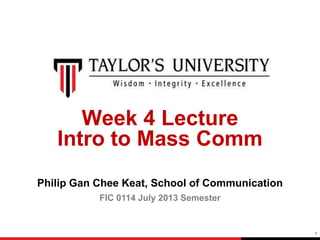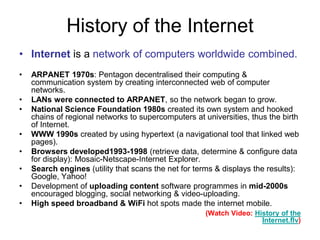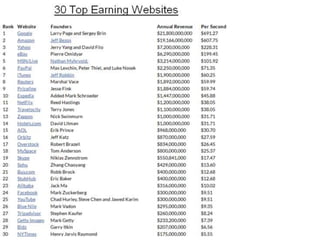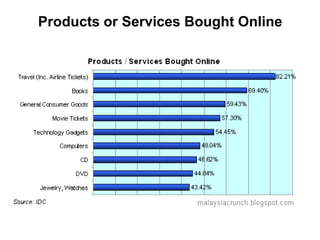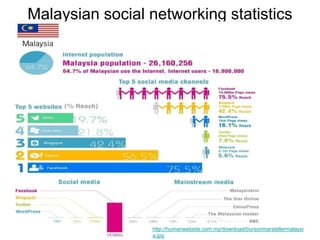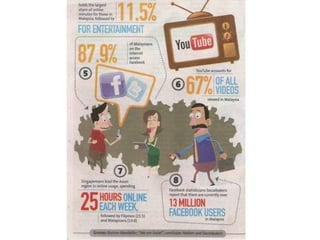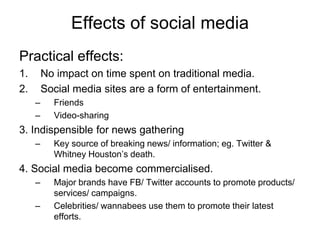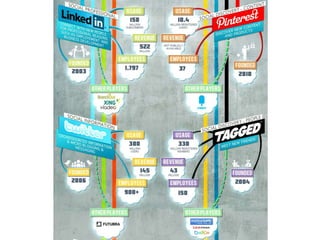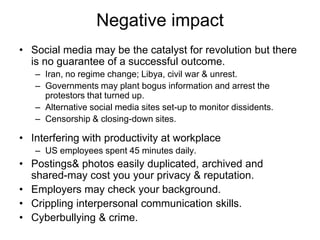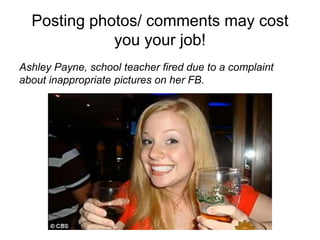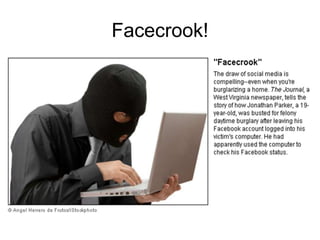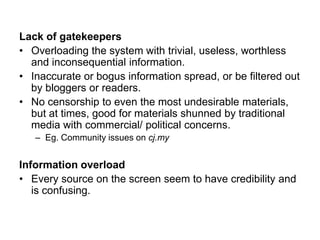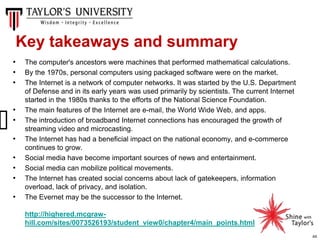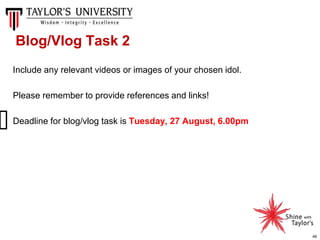F0114 l4 internet (without narration)
- 1. 1 Week 4 Lecture Intro to Mass Comm Philip Gan Chee Keat, School of Communication FIC 0114 July 2013 Semester
- 2. The Internet and social media
- 3. Objectives: • History of the computer • History of WWW and Internet development • Advantages of broadband Internet access • Potential impact of Web 2.0 • Recognise the economic impact of the internet • Social concerns of Internet use
- 4. • Bill Gates (1999): “Internet changes everything.” • Economy, science, education, communication & culture. • New channels of communication, eg. Youtube, Facebook, Twitter & blogs challenged the supremacy of traditional mass communication.
- 5. History of computer • Blaise Pascal & Gottfried Wilheim von Leibneitz created adding machines for calculations & birth of binary system. • Herman Hollerith (1880s) who founded IBM created a machine that used punch cards and electric circuits. • Howard Aiken (1940s) created the first computer with binary system. • John Mauchly & co. (1946) created ENIAC, first all electronic computer. • Home PCs (1970s) created. • Modem & local area networks (LAN) (1980s) allowed computers to be linked together. • Miniaturisation (1990s) popularised laptops. • iPads (2009) & other tablets. • Cloud computing (2010-) refers to applications & services offered over the Net (stored on servers, and not on your computers). (Watch Video – History of Computers.flv)
- 6. History of the Internet • Internet is a network of computers worldwide combined. • ARPANET 1970s: Pentagon decentralised their computing & communication system by creating interconnected web of computer networks. • LANs were connected to ARPANET, so the network began to grow. • National Science Foundation 1980s created its own system and hooked chains of regional networks to supercomputers at universities, thus the birth of Internet. • WWW 1990s created by using hypertext (a navigational tool that linked web pages). • Browsers developed1993-1998 (retrieve data, determine & configure data for display): Mosaic-Netscape-Internet Explorer. • Search engines (utility that scans the net for terms & displays the results): Google, Yahoo! • Development of uploading content software programmes in mid-2000s encouraged blogging, social networking & video-uploading. • High speed broadband & WiFi hot spots made the internet mobile. (Watch Video: History of the Internet.flv)
- 7. Les Horribles Cernettes (first image uploaded on the web 18 July 1992)
- 8. The Evolving Internet Trends affecting the development in future: Broadband • Multiple channels to data transmission (satellite & cable modems/ digital subscriber line -DSL). • Provides tremendous speed to connection to the internet • Able to support downloads & uploads of huge audio & video files. • Makes possible video-on-demand, interactive television, live streaming video & downloadable movies. • 2011: M’sian household broadband penetration soared to 65%, and expected to exceed 75% in 2015.
- 9. Mobile-Wireless • Net access through wireless technology-mobiles, tablets & laptops increased tremendously. • WiFi (wireless fidelity) uses low power radio signals to connect computers to the internet. • Hot spots (public WiFi acess locations) are base stations/ transmitter to hook mobiles, laptops & tablets. • WiMax is hoped to be pervasive enough to transmit signals within the range of 10 miles in metropolitan areas.
- 10. Monetising the web • Charged services (& merchandise) provided by companies online. – Second Life (3D virtual world): virtual real estates sold to real companies to market their products! (Watch Video – Second Life The Online 3D Virtual World.flv) – FB, Hulu, Google, Youtube: charges for ad spaces. – iTunes charges for music downloads. – Apps for mobile media are a big business – generating $4b in revenue in 2010 • Big companies commercially invest in big websites to generate profits or awareness. – News Corporation: MySpace – Google: Youtube • Traditional media are losing its audience, so advertisers turn to the internet.
- 11. Blogs • Online journals whereby people write about their topic of interest, and readers can comment & engage virtually with the writer. • Age: 52% are 18-34; mommy bloggers monetise • More youngsters turn to FB & Twitter & bloggers use them to popularise their blogs. – Political blogs (Che Det, Limkitsiang blog); – war blogs (Kevin Sites); – Tsunami blogs; – celebrity blogs (TMZ; Perez Hilton). – LGBT Blogs (Towleroad, HuffPost Gay Voices)
- 13. The Internet & National Economy (US) • Internet had created more than 1.2 million jobs. • Direct economic value: US$185 billion – $90 billion retail sales – $70 billion to ISPs – $26 million advertising • Online advertising (15% of all ad expenditure in the USA) is growing-chipping away newspaper advertising. Internet Economics and New Online Mega- companies
- 14. New mega-companies • The Internet had birthed new mega-companies that dominates the internet in different market areas. • They produce little content, but primarily distribute them.
- 16. http://www.marketingmagazine.com.my/index.php/digital/127- digital-news/7788-malaysian-website-rankings-for-january-2012- UB: Unique browsers PV: Page Views ASD: Average Session Duration APVPS: Average Page Views Per Session
- 17. Website Economics Three ways to make a profit: 1.Create websites with specialised content & large numbers of readers. – Newspapers: WSJ; NYTimes; Malaysiakini – Pornography 2.Sell merchandise/ services online – Amazon.com; Lelong.com 3.Sell advertising: 1. paid search ad (sponsored links); 2. display ads (banners, pop-ups); 3.classified – Google; Yahoo
- 18. Malaysian Internet Users VS Buying Online
- 19. Products or Services Bought Online
- 20. The Internet audience • Data of internet audience come from comScore and Nielsen/Netratings. • Infant stage: White males, high income & education. • Childhood by 2000: females at par with males; minority families; modest levels of income & education. • Maturity by 2011, USA’s internet population reflects the general population.
- 21. Malaysian Internet Audience There is now 64.7% Internet users in Malaysia, as of October 2012
- 22. Malaysian statistics (Jan 2012) Malaysian Digital Association
- 23. NMR 2011
- 24. http://www.marketingmagazine.com.my/index.php/digital/127- digital-news/7788-malaysian-website-rankings-for-january-2012- UB: Unique browsers PV: Page Views ASD: Average Session Duration APVPS: Average Page Views Per Session
- 25. Social media • Defined as: the use of web based & mobile technology to turn communication into interactive dialogue. • Social media allows us to: – Participate (voting) – Converse (comment) – Share – Collaborate (creating content in groups) – Link up
- 26. Malaysian social networking statistics http://humanwebsite.com.my/download/bursonmarstellermalaysi a.jpg
- 29. Internet 2012 in Numbers http://royal.pingdom.com/2013/0 1/16/internet-2012-in-numbers/
- 30. Effects of social media Practical effects: 1. No impact on time spent on traditional media. 2. Social media sites are a form of entertainment. – Friends – Video-sharing 3. Indispensible for news gathering – Key source of breaking news/ information; eg. Twitter & Whitney Houston’s death. 4. Social media become commercialised. – Major brands have FB/ Twitter accounts to promote products/ services/ campaigns. – Celebrities/ wannabees use them to promote their latest efforts.
- 33. Social media as mobilisers • Can be used to mobilise crowds to do something at a certain place and time. – Flashmobs – Protests & demonstrations against incompetent governments; Tunisia, Libya, Egypt, Iran • Started in Tunisia (unemployed man set himself on fire) • Spread to Egypt (Khaled Said beaten to death by the police) – Egyptian protestor against Hosni Mubarak (2011): FB: to schedule; Twitter: to coordinate; Youtube: to tell the world.
- 34. Negative impact • Social media may be the catalyst for revolution but there is no guarantee of a successful outcome. – Iran, no regime change; Libya, civil war & unrest. – Governments may plant bogus information and arrest the protestors that turned up. – Alternative social media sites set-up to monitor dissidents. – Censorship & closing-down sites. • Interfering with productivity at workplace – US employees spent 45 minutes daily. • Postings& photos easily duplicated, archived and shared-may cost you your privacy & reputation. • Employers may check your background. • Crippling interpersonal communication skills. • Cyberbullying & crime.
- 35. Posting photos/ comments may cost you your job! Ashley Payne, school teacher fired due to a complaint about inappropriate pictures on her FB.
- 37. Facecrook!
- 38. The social implications of the internet A new model for news • The internet supplements the traditional surveillance function-news media. Audience contribution accepted. • No more-top-down lecture(editor decides-readers receive), but sideways conversation(editor decides- anyone interested can contribute). • Provides check & balance on journalism, and demands transparency (accountability to the public). • Magnifies the interpretation function, by providing access to different blogs with unique opinion.
- 39. The social implications of the internet on NEWS
- 41. Lack of gatekeepers • Overloading the system with trivial, useless, worthless and inconsequential information. • Inaccurate or bogus information spread, or be filtered out by bloggers or readers. • No censorship to even the most undesirable materials, but at times, good for materials shunned by traditional media with commercial/ political concerns. – Eg. Community issues on cj.my Information overload • Every source on the screen seem to have credibility and is confusing.
- 42. Privacy concerns • Hacking & stolen personal data • Companies mining personal data from online activities. • Identity theft • Malaysia Personal Data Protection Act 2010 (watch the Deloitte Malaysia Consulting Personal Data Protection Act 2010.flv Escapism & isolation • Internet addiction (& Facebook Addiction Disease) (Videos-PDPA & FAD)
- 43. The Evernet, ever pervasive & ever present! • The term Evernet has been used to describe the convergence of wireless, broadband, and Internet telephony technologies that will result in the ability to be continuously connected to the Web anywhere using virtually any information device (Techtarget.com 2012). (Video-Johnny Mnemonic) • Also watch the Michio Kaku video, as he talks about one day, we will wear the Internet!
- 44. 44 • The computer's ancestors were machines that performed mathematical calculations. • By the 1970s, personal computers using packaged software were on the market. • The Internet is a network of computer networks. It was started by the U.S. Department of Defense and in its early years was used primarily by scientists. The current Internet started in the 1980s thanks to the efforts of the National Science Foundation. • The main features of the Internet are e-mail, the World Wide Web, and apps. • The introduction of broadband Internet connections has encouraged the growth of streaming video and microcasting. • The Internet has had a beneficial impact on the national economy, and e-commerce continues to grow. • Social media have become important sources of news and entertainment. • Social media can mobilize political movements. • The Internet has created social concerns about lack of gatekeepers, information overload, lack of privacy, and isolation. • The Evernet may be the successor to the Internet. http://highered.mcgraw- hill.com/sites/0073526193/student_view0/chapter4/main_points.html Key takeaways and summary
- 45. 45 Think of an idol (a celebrity, royal, media or political figure) who is loved by most young people. (600-750 words max.) a. Provide some background information to this famous person and some controversies he/ she is involved in. (150w) b. What aspects of the famous person’s behavior or lifestyle would young people tend to follow? (100w) c. What are the negative and positive effects on young people’s behaviour if they were to emulate the aspects mentioned above? (100w) d. Do you think the famous person could promote other positive values/ behavior to young people? (Did the idol promote any social campaigns? Or, did the controversies, he/she is involved in bring forth any good outcomes to society?) (150w) e. As an agent of socialization, how did the media portray the celebrity you have mentioned? (100w) Blog/Vlog Task 2
- 46. 46 Include any relevant videos or images of your chosen idol. Please remember to provide references and links! Deadline for blog/vlog task is Tuesday, 27 August, 6.00pm Blog/Vlog Task 2
- 47. 47 Quiz 3 is up since Monday, 19th August. Deadline is Friday, 23rd August, midnight. Quiz 4 will be up on Monday, 26th August. Deadline is Monday, 2nd September, midnight. Quizzes 3 and 4
- 48. 48 any Questions
- 49. 49 thank You
